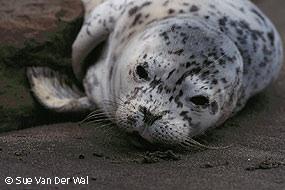Expect some access restrictions at Point Reyes National Seashore beginning Monday. That's because the harbor seal pupping season is upon us, and the national seashore boasts the "largest mainland, breeding colony of harbor seals in California."
"Resting and pupping harbor seals come onshore in various parts of the park particularly in Tomales Bay, Tomales Point, Double Point, Drakes Estero and Bolinas Lagoon," say park officials. "Each year, several thousand seals congregate within the Seashore especially to give birth on the sand bars and remote beaches."
As a result of this crush of seals, from March 1 through June 30 seashore officials will implement their annual closure of Drakes Estero to protect the harbor seals during this most sensitive time of year. The closure applies to kayak and canoe usage and is applicable to surfers, windsurfers, abalone divers, recreational fishing and other water sport users around harbor seal colonies in the area, according to the Park Service.
How big of a deal is this? Last year about 3,500 harbor seals were counted, 1,000 of which were pups, park officials say. The number of seals breeding at Point Reyes represents around 20 percent of the California mainland population estimate. The seashore staff is conducting long-term monitoring to gain further scientific knowledge on this species and to guide management in their protection.
The east side of Hog Island in Tomales Bay is also a terrestrial resting site for harbor seals and seabirds’ year round, park officials note. Harbor seals haul out on the sand bar at Hog Island throughout the year but are most abundant during the winter when their preferred prey, Pacific herring, spawn in Tomales Bay. During the spring months, females with pups may also haul out there.
To ensure that harbor seals are not disturbed, visitors are asked to stay at least 100 yards (300 feet) away from resting seals. Visitors should never pick up a seal pup that may look abandoned. While harbor seal pups might appear abandoned, they are most likely waiting for their mother to return.
Pups are about two feet long and weigh about 24 pounds and are weaned at 30 days after birth.
Harbor seals are protected under the Marine Mammal Protection Act of 1972 and therefore, it is unlawful to disturb them while they are resting onshore.


 Support Essential Coverage of Essential Places
Support Essential Coverage of Essential Places






